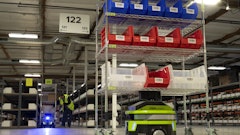Investment in supply chain management (SCM) applications, which topped $6 billion last year and is expected to reach an impressive $7.4 billion by 2010, (according to AMR Research) should never be considered a waste. Still, as companies have piled more products, suppliers and distribution plants into their supply chain scenario and changed replenishment strategies, a slow erosion of effectiveness has followed.
But despite the increasing investments in supply chain effectiveness, many companies are finding that such key metrics as on-time delivery, order fulfillment lead time and supply chain response tend to slide as time passes.
In fact, it's likely that your supply chain isn't operating at its peak efficiency right now. Supply chain opportunity assessments can help you determine if this may actually be happening at your company. Like an annual doctor's physical provides a snapshot of overall health, a supply chain opportunity assessment will give your company a complete look at the overall state of one of its most critical functions and provide with you a comprehensive list of opportunities for improvement.
Armed with the report from a supply chain opportunity assessment, a company can immediately begin to take a series of actions to help improve its operating efficiency and ensure that the supply chain is structured to meet any growth trends or expected sales increases. An assessment also guarantees that processes and data can be more tightly integrated and shared with partners, helping fulfill the ultimate goal of realigning the supply chain with business and operations strategies.
Though an assessment might sound intimidating, it's a pretty straightforward and proven analysis process that entails a thorough review and examination of a company's existing supply chain processes. It's also a method that's been proven to work across industries and has been used to improve supply chain performance in businesses ranging from consumer packaging to semiconductors to communications devices.
The following is a working framework to consider when planning a comprehensive supply chain assessment.
1) First, consider the scope of an assessment. Will it be limited to a division or business unit or include the entire corporation? Will you look at a subset of supply chain processes or examine the full spectrum, including demand planning, supply planning, production scheduling, supply replenishment and order promising? Once the scope of the assessment is determined, identify the company's existing concerns in areas such as demand and supply planning, production scheduling, inventory planning and order promising. (One key strategy, from the start, is to recruit the right people to work on the assessment, including both the key stakeholders that own the supply chain process and those managers in all applicable business units.)
2) Examine the ongoing challenges within your business model by looking at how the existing supply chain organization is structured. Identify all the roles and responsibilities of employees involved in every process. Document how information, materials and financials flow through the organization. Also, track the metrics the company now uses to measure supply chain success and effectiveness. (It's particularly crucial to use a trusted vendor's well-defined process to collect this data. This will help the company avoid spending too much time on data collection, often done at the expense of the quality of data gathered or resulting in inflated consulting fees.)
3) Uncover and document the key issues that are impacting supply chain performance and perform a root-cause analysis. Here, a company will identify many problems — everything from latency in its commit process with contract manufacturers to a lack of visibility into customer business plans to delays caused by design changes to a new product. Where possible, compare the company's existing processes to industry best practices.
4) Identify and prioritize opportunities for improvement. Once the key issues are identified, opportunities for their improvement can be prioritized based on their potential business impact and the relative ease with which they can be realized. Areas of improvement within your company may include automating the existing manual processes, such as the use of Excel spreadsheets during demand planning; modifying supply chain process to achieve objectives such as deploying a S&OP process to improve alignment between demand and supply or increasing collaboration within the supply chain to increase visibility and velocity; and identifying key supply chain dashboard metrics to improve accountability and enable performance improvement. The graphic below shows an example of a 2X2 matrix approach used to identify high-impact areas. In this scenario, the primary focus for the client was on deploying processes and systems that streamline the supply chain.
Figure 1: 2X2 Matrix Approach
5) Develop a solutions roadmap. This roadmap should estimate what it will take to make the improvements, including the estimated time to fix problems and the overall cost. It should also provide a series of detailed steps and a timeline to implement the recommendations.
Of course, change within the supply chain will not happen overnight. During any assessment process many potential challenges will emerge, including a lack of integration among processes or poor visibility into a company's own systems and the systems shared with manufacturers.
Some companies are overwhelmed by inventory. Others don't have any plan in place to handle order backlog from seasonal or unexpected fluctuations in sales or the means to handle the frequency of new product launches.
Still more are failing to use correct methods to measure many key supply chain functions. The good news is that through a thorough assessment, all of these problems can be identified, prioritized and then addressed over time.
Companies that have conducted a supply chain opportunity assessment and adhered to a roadmap of supply chain changes report many short- and long-term benefits, including reduced inventory, increased velocity, higher on-time delivery, lower supply chain management costs, reduced transportation costs, a lower total cost of ownership and higher sales growth.
Best of all, they are squeezing the most out of their supply chains. And they no longer worry about not achieving peak performance.
About the Authors: Jessie Chimni is vice president of Services and Ashok Santhanam is the CEO of Bristlecone, a supply chain consulting firm (www.bcone.com). Bristlecone brings expertise across the entire spectrum of supply chain, including demand planning, supply planning, network collaboration, sourcing and analytics. In addition Bristlecone provides supply chain-focused KPO services.















